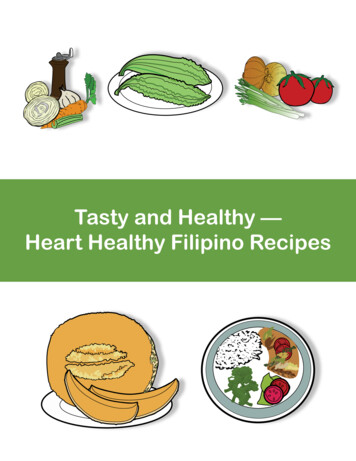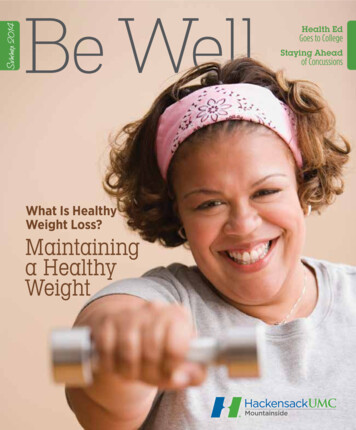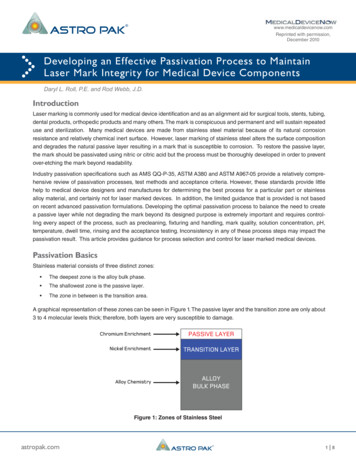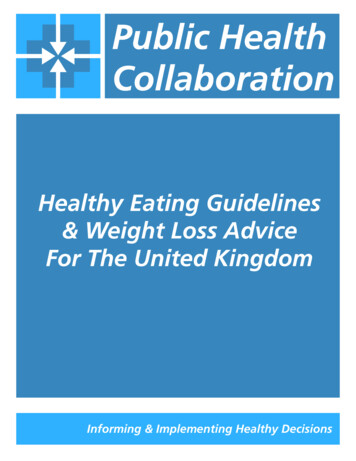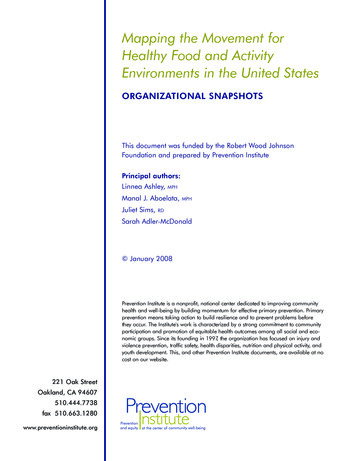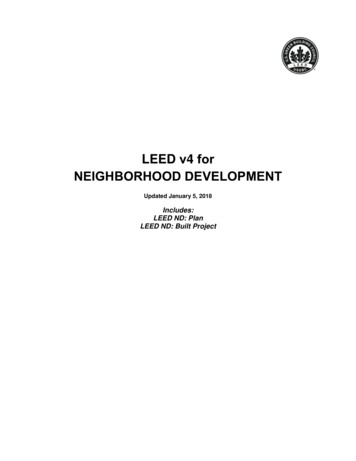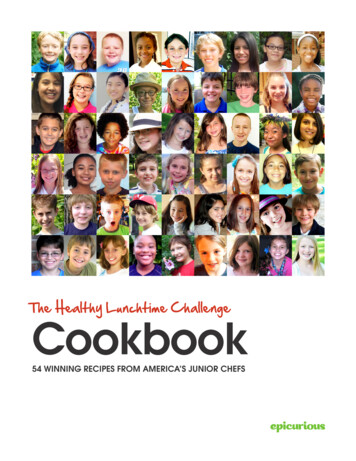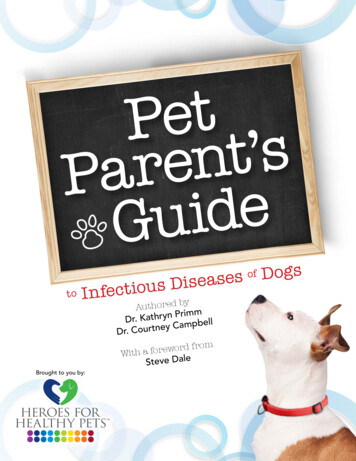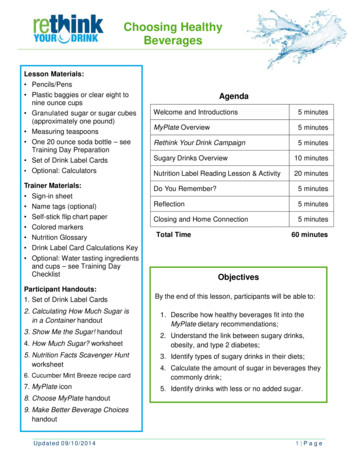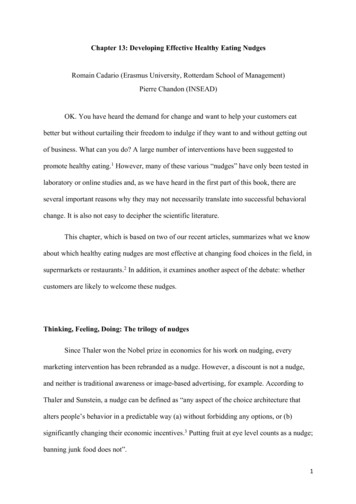
Transcription
Chapter 13: Developing Effective Healthy Eating NudgesRomain Cadario (Erasmus University, Rotterdam School of Management)Pierre Chandon (INSEAD)OK. You have heard the demand for change and want to help your customers eatbetter but without curtailing their freedom to indulge if they want to and without getting outof business. What can you do? A large number of interventions have been suggested topromote healthy eating.1 However, many of these various “nudges” have only been tested inlaboratory or online studies and, as we have heard in the first part of this book, there areseveral important reasons why they may not necessarily translate into successful behavioralchange. It is also not easy to decipher the scientific literature.This chapter, which is based on two of our recent articles, summarizes what we knowabout which healthy eating nudges are most effective at changing food choices in the field, insupermarkets or restaurants.2 In addition, it examines another aspect of the debate: whethercustomers are likely to welcome these nudges.Thinking, Feeling, Doing: The trilogy of nudgesSince Thaler won the Nobel prize in economics for his work on nudging, everymarketing intervention has been rebranded as a nudge. However, a discount is not a nudge,and neither is traditional awareness or image-based advertising, for example. According toThaler and Sunstein, a nudge can be defined as “any aspect of the choice architecture thatalters people’s behavior in a predictable way (a) without forbidding any options, or (b)significantly changing their economic incentives.3 Putting fruit at eye level counts as a nudge;banning junk food does not”.1
Even this restricted definition of nudges encompasses a wide variety of interventions,including various labeling schemes, changes to the visibility of different food or reductions ofplate and portion size. In this first section, we provide a framework to classify nudges. Wedraw on the classic tripartite classification of mental activities into cognition (thinking),affect (feeling), and behavior (doing). This so-called trilogy of mind has long been adopted inpsychology and marketing to understand consumer behavior and predict the effectiveness ofmarketing actions.4We distinguish between (a) cognitively oriented nudges that seek to influence whatconsumers think, (b) affectively oriented nudges that seek to influence how consumers feelwithout necessarily changing what they know, and (c) behaviorally oriented nudges that seekto influence what consumers do (i.e., their motor responses) without necessarily changingwhat they know or how they feel. Within each type, we further distinguish subtypes thatshare similar characteristics, ending with seven nudges overall.Thinking: Informing the brain about what is healthy with cognitive nudgesThere are three types of cognitive nudges. The first type, “descriptive nutritionallabeling,” provides calorie count or information about other nutrients, be it on menus or menuboards in restaurants, or on labels on the food packaging or near the foods in self-servicecafeteria and grocery stores.The second type, “evaluative nutritional labeling,” typically (but not always) providesnutrition information but also helps consumers interpret it through color coding (e.g., red,yellow, green as nutritive value increases) or by adding special symbols or marks (e.g., hearthealthy logos or smileys on menus) or simplifying schemes (e.g., Nutri-Score’s A to Ecategories).2
Nudge ionallabelingVisibilityenhancementsHealthy entsSizeenhancementsIconDefinition and exampleCognitive nudgesLabels in supermarkets, cafeterias, and chain restaurants (suchas McDonald’s, Pizza Hut) with calorie and nutrition facts.For example, the shelf label or the menu board provideinformation about calorie, fat, sugar and salt content.Labels in supermarkets, cafeterias, and chain restaurants (suchas McDonald’s, Pizza Hut) providing color-coded nutritioninformation that easily identifies healthier foods.For example, the shelf label or the menu board provideinformation about calorie and fat content and a green sticker ifthe food is healthy or a red sticker if the food is unhealthy.Supermarkets, cafeterias, and chain restaurants (such asMcDonald’s, Pizza Hut) make healthy food more visible andunhealthy food less visible.For example, supermarkets place healthy food rather thanunhealthy food near cash registers and cafeteria or restaurantmake healthy food visible and easy to find on their menu andunhealthy food harder to find on their menu.Affective nudgesStaff in supermarkets, cafeterias, and chain restaurants (such asMcDonald’s, Pizza Hut) prod consumers to eat more healthily.For example, supermarket or cafeteria cashiers or restaurantwaiters ask customers if they would like to have fruits orvegetables.Supermarkets, cafeterias, and chain restaurants (such asMcDonald’s, Pizza Hut) make healthy food more appealingand unhealthy food less appealing.For example, healthy foods are displayed more attractively incafeteria counters or are described in a more appealing andappetizing way on menus.Behavioral nudgesCafeterias and chain restaurants (such as McDonald’s, PizzaHut) include healthy food as default in their menu andsupermarkets to make unhealthy food physically harder toreach on the shelves.For example, vegetables are included by default in combomeals or in fixed menus in cafeterias and chain restaurants, butcustomers can ask for a replacement.Supermarkets, cafeterias and chain restaurants (such asMcDonald’s, Pizza Hut) reduce the size of the packages orportions of unhealthy food that they sell and to increase thesize of the packages or portions of healthy foods that they sell.For example, cafeterias and restaurants serve smaller portionsof fries and larger portions of vegetables or supermarkets sellsmaller candy bars and larger strawberry trays.3
Although the third type, “visibility enhancement,” does not directly provide health ornutrition information, it is a cognitively oriented intervention because it informs consumersof the availability of healthy options by increasing their visibility on grocery or cafeteriashelves (e.g., placing healthy options at eye level and unhealthy options on the bottom shelf)or on restaurant menus (e.g., placing healthy options on the first page and burying unhealthyones in the middle).Feeling: Seducing the heart with affective nudgesThe first type of affectively-oriented interventions, which we call “pleasure appeals,”seeks to increase the hedonic appeal of healthy options by using vivid hedonic descriptions(e.g., “Twisted citrus-glazed carrots”) or attractive displays, photos, or containers (e.g.,“pyramids of fruits”).The second type of affectively oriented interventions, “healthy eating calls,” directlyencourages people to do better. This can be done by placing signs or stickers (e.g., “Make afresh choice,” or “Have a tossed salad for lunch!”) or by asking foodservice staff to verballyencourage people to choose a healthy option (e.g., asking “which vegetable would you like tohave for lunch?”) or to change their unhealthy choices (e.g., “Your meal doesn’t look like abalanced meal” or “Would you like to take half a portion of your side dish?”).Doing: Manipulating the hands with behavioral nudgesThe third group consists of two types of interventions that aim to impact people’sbehaviors without necessarily influencing what they know or how they feel, often withoutpeople being aware of their existence. “Convenience enhancements” make it physically easier4
for people to select healthy options (e.g., by making them the default option or placing themin faster “grab & go” cafeteria lines) or to consume them (e.g., by pre-slicing fruits or preserving vegetables), or make it more cumbersome to select or consume unhealthy options(e.g., by placing them later in the cafeteria line when trays are already full or by providingless convenient serving utensils).The second type, which we call “size enhancements,” modifies the size of the plate,bowl, or glass, or the size of pre-plated portions, either increasing the amount of healthy foodthey contain or, most commonly, reducing the amount of unhealthy foodHands above hearts above Brains: Which type of nudge works best?We tested this framework with a meta-analysis of published field experiments, whichallows us to measure the average effectiveness of a given nudge type across many studies.5Our meta-analysis reviewed real-life experiments rather than lab- or online-based studiesbecause, when it comes to food choices, there's an important intention-action gap betweenwhat people say they eat and what they actually eat when no one is watching. Overall, themeta-analysis covered 96 field experiments published in 90 academic articles.We collated information about the experiments and measured the effectiveness ofeach type of nudge using the standardized mean difference (also known as Cohen’s d), whichallows us to pool the results across various units of measurements and foods. To get a moreintuitive grasp of nudge effectiveness, we converted them into the daily energy equivalent,expressed in number of sugar cube. For example, if a nudge can reduce consumption by 100calories a day, it’s the equivalent of ten fewer sugar cubes.Our key finding is that the effectiveness of nudges increases as they shift fromcognition/thinking (d 0.12, 64 kcal) to affect/ feeling (d 0.24, 129 kcal) to5
behavior/doing (d 0.39, 209 kcal). In other words, the hand is stronger than the heart,which is stronger than the brain. Figure 1 summarizes the average effectiveness of our sevenidentified heathy eating nudges, measured in daily decrease in energy intake transformed intosugar cube equivalents.Fig 1. Average nudge effectiveness from the meta-analysis(source: Cadario & Chandon 2020)Expected reduction in dailycalorie intakeOne sugar cube 10 kcalBehavioral nudges:Doing32Affective nudges:FeelingCognitive ivelabelingVisibilityenhancementsHealthyeating callsPleasureappealsSizeConvenienceenhancement enhancements?The disappointing effects of cognitive nudgesDescriptive labeling. Information alone, that is nutritional facts with no color-codingor symbols to help people interpret the numbers, do not move the dial very much in terms ofmaking healthy choices. Expected calorie reduction five sugar cubes.Evaluative labeling. When we know how healthy something is in relation tosomething else, in the form of a summary score, a smiley face or traffic light food labelling,the information has some impact on our choices. We understand that a red light means“stop”, even in the grocery store. In fact, a large randomized controlled trial in 606
supermarkets showed that simplified front-of-pack nutrition labels help sell good foods.6However, they did not reduce the sales of “bad” foods and there was a significant “voltagedrop): their effects were 17 times lower overall than in comparable laboratory studies.Expected calorie reduction nine sugar cubes.Visibility enhancements. Another nudge that informs our brains is one that puts thehealthiest product in the most visible place – at eye level on a shelf or on the best place in themiddle of a menu. Still, it didn’t have a significant impact on making better choices.Expected calorie reduction seven sugar cubes.In conclusion, targeting thinking is not enough! Cognitive nudges are trying to informus about the healthiness of the food options, either by displaying nutrition information ortraffic light symbols or by placing the healthiest food right where we will see them. Clearly,they are not ideal. Nudges that inform only have a small impact on our food decisions,reducing our intake by the equivalent of five to nine sugar cubes per day. This is not assurprising as it sounds since people already know that they should replace calorie-densesnacks with fruits and vegetables or sodas with water. The difficulty is converting thisknowledge into action, and that requires the motivation to act and aids that help to followthrough on one’s intentions. This is where affective and behavioral nudges can help.Affective nudges: Social pressure and pleasure as allies of healthy eatingHealthy eating calls. This type of nudge can be implemented by asking the cashier toask customers if they want a salad with their burger or by placing signs up encouragingpeople to “make a fresh choice”. On average, these nudges can expect a daily caloriereduction of nearly 13 sugar cubes.7
Pleasure appeals. These nudges emphasize the taste or the sensory characteristics ofthe food. Instead of telling us that carrots are rich in antioxidants, they are described as“twisted citrus-glazed carrots” to draw attention to how they might taste or feel. Expectedcalorie reduction 17 sugar cubes.Instead of informing people about nutrition or the availability of healthier options, ascognitive/thinking nudges do, affective nudges try to motivate us to eat foods that we alreadyknow are better for us by playing up their delicious taste or texture or by leveraging socialpressure? These tend to be effective, reducing our calorie intake by the equivalent of 13 to 17sugar cubes.Behavioral nudges: When doing beats seducing and informingConvenience enhancements. These nudges make selecting or consuming healthierfoods the easy option. It can be done by placing indulgent foods at the end of the cafeterialine, when our tray is already full of healthier foods. Another convenience enhancement is topre-cut, pre-plate fruit or vegetables. After all, it’s much easier to eat peeled and choppedpineapple than a whole one. Expected calorie reduction nearly 20 sugar cubes.Size enhancements. The most effective nudges directly change how much food is puton plates or the size of the bottle. This is still technically a nudge as long as the unit pricestays the same. Although there have been inconsistent results, simply reducing the size of theplate or glass may also help, if people use it as a cue to decide how much to serve themselves.Expected calorie reduction 32 sugar cubes.In conclusion, behavioral nudges try to influence what we do directly, withoutchanging what we know or what we want. They are by far the most effective as they can saveus up to 32 sugar cubes worth of calories. At least when it comes to eating, feelings beat8
thinking and doing beat feelings. If public policy and food businesses want to help consumerseat better, our findings suggest focusing on developing behavioral nudges.Manipulative but effective: Consumer approval of healthy eating nudgesIf behavioral nudges are so much more effective than cognitive or even affective ones,why are most policy debates about how to best inform people, for example, with nutritionlabels, rather than about how to shrink package size or downsize restaurant food portions?The answer is fear of consumer reactance. Developing effective healthy eating nudges shouldnot only be driven by effectiveness considerations. We must take into account consumerapproval. This is what we did in a second study, for which we recruited Americanparticipants to evaluate the seven healthy eating nudges presented in the previous section.7Measuring consumer approval of nudgesEach nudge was presented with a specific scenario, as shown in the table below. Wefirst showed the nudge type, logo, and description of one the seven nudges, selected inrandom order. We then measured nudge approval using binary scales (“Do you approve ordisapprove of the following policy?”, Approve/disapprove) and perceived effectiveness (“Doyou think that this policy will make people eat better?”, Yes it will/No it will not). Weobtained similar results when asking people to rate the nudge on a 13-point scale labeledfrom to A to F. Last, we asked people who would be the primary beneficiary of each nudge,from three options: 1) “Primarily consumer health (little or negative impact on business),” 2)“Primarily business (little or negative impact on health),” 3) “It will be a win-win (bothhealth and business will benefit)”.9
Effective or accepted: Tradeoffs in selecting nudgesOur results found only moderate acceptance of the 7 healthy eating nudges. Theaverage approval rate was 64% for women and 52% for men. To further examine therelationship between these scores and the actual effectiveness of the nudge, we plotted on theY-axis of Figure 2 the percentage of respondents who approved the nudge. The X-axis showsthe actual effect size of each nudge estimated in the meta-analysis presented in the previoussection. The cognitive nudges are presented in blue, the affective nudges in green, and thebehavior nudges in red.Fig 2. Nudge effectiveness is inversely related to consumer approval(Source: Cadario & Chandon 2019)Consumers approving the eenhancementsHedonicHealthy eating enhancementscalls25%r -0.570%00.20.40.60.8Actual effectiveness of the nudge(Cohen's d from Cadario & Chandon 2020)Figure 2 shows that the actual effectiveness of these nudges was inversely related totheir mean approval rating (r -.57). Whereas 85% approved of descriptive labeling, the leasteffective nudge, only 43% approved portion size changes, the most effective intervention. In10
additional analyses, we examined the drivers of consumer approval, as function of actualnudge effectiveness, perceived nudge effectiveness, as well as perceived beneficiary of thenudge. We found that that approval was positively associated with the perceivedeffectiveness of the nudge. Importantly, we found that healthy eating nudges perceived as a“win-win” for business and health had higher approval than interventions perceived asbenefiting either health or business, and that there were no differences in approval betweeneach of these respectively. That is, the more people expected a nudge to be effective, and themore they perceived it to be a win-win for both business and health, the more likely theywere to approve of the nudge.Key takeaways and implicationsIn conclusion, we find clear evidence that not all nudges are created equal. This is truein terms of their effectiveness and their acceptance by citizens and consumers alike. In ourview, it is time to move beyond discussing the value of nudging in general to consider boththe expected effectiveness and public acceptance of specific types of nudges.At first glance, our results seem to lead to a conundrum. On the one hand, we find thatthe effectiveness of healthy eating interventions increases as their focus shifts from cognitionto affect to behavior. On the other hand, we find that consumer approval of the nudgesdecreases with their effectiveness. Unless one is a benevolent dictator, a parent for example,this suggests that managers or public servants that are beholden to the support of their clientsor citizens cannot simply go with “what works best”. Simply being transparent about nudgescan impair their implementation as the majority of people are likely to disapprove of them.Yet, our results also offer a solution. The crux of the problem is not that people dislikebeing nudged, or that they disapprove of nudges that help businesses, but that they are poor11
judges of which nudges are effective. So, the first conclusion is that we first need to listen toconsumers, to find out what they think of the nudges that we intend to implement. The secondconclusion is that we must frame nudges appropriately, highlighting their effectiveness aswell as highlighting that they can be a win-win for all.Given this, priority should go to nudges that achieve multiple goals, such as“Epicurean nudges” focused on the pleasure (vs. health benefits) of portion control, whichdeliver both business and health benefits because pleasure in food does not increase withquantity, but with quality and savoring.8 Since people tend to approve of the nudges that theyperceive to be effective, approval rates for powerful nudges like size and convenienceenhancements can be improved if people learn that they are three times more effective thandescriptive or prescriptive labeling.Overall, healthy eating nudges are a valuable addition to the traditional public policytoolbox of tax incentives and regulations.9 However, the controversy over the newsfeedexperiments conducted at Facebook without explicit consent reminds us that we can nolonger assume that people will accept to be nudged as long as the objective of the nudge iscommendable.10 Rather than framing the debate as nudging versus traditional tools, specificnudges should be compared to specific tools on both their effects and their acceptance.12
Notes1Hollands, G.J., et al., Portion, Package or Tableware Size for Changing Selection and Consumption of Food,Alcohol and Tobacco. Cochrane Database Syst Rev, 2015. 9: p. CD011045.2See Cadario, R. and P. Chandon, Which Healthy Eating Nudges Work Best? A Meta-Analysis of FieldExperiments. Marketing Science, 2020. 39(3): p. 465-486; and Cadario, R. and P. Chandon, Effectiveness orconsumer acceptance? Tradeoffs in selecting healthy eating nudges. Food Policy, 2019. 85(May): p. 1-6.3Thaler, R.H. and C.R. Sunstein, Nudge: Improving Decisions about Health, Wealth, and Happiness. 2008,New York: Penguin Books. 312 pages.4See, for example, Hanssens, D.M., et al., Consumer Attitude Metrics for Guiding Marketing Mix Decisions.Marketing Science, 2014. 33(4): p. 534-550.5Cadario, R. and P. Chandon, Which Healthy Eating Nudges Work Best? A Meta-Analysis of Field Experiments.Marketing Science, 2020. 39(3): p. 465-486.6Dubois, P., et al., Effects of front-of-pack labels on the nutritional quality of supermarket food purchases:evidence from a large-scale randomized controlled trial. Journal of the Academy of Marketing Science, 2021.49: p. 119-138.7Cadario, R. and P. Chandon, Effectiveness or consumer acceptance? Tradeoffs in selecting healthy eatingnudges. Food Policy, 2019. 85(May): p. 1-6.8Cornil, Y. and P. Chandon, Pleasure as a Substitute for Size: How Multisensory Imagery Can Make PeopleHappier with Smaller Food Portions. Journal of Marketing Research, 2016. 53(5): p. 847-864.9Benartzi, S., et al., Should Governments Invest More in Nudging? Psychological Science, 2017. 28(8): p. 10411055.10Verma, I.M., Editorial Expression of Concern: Experimental evidence of massivescale emotional contagionthrough social networks. Proceedings of the National Academy of Sciences, 2014. 111(29): p. 10779-10779.13
as McDonald’s, Pizza Hut) with calorie and nutrition facts. For example, the shelf label or the menu board provide information about calorie, fat, sugar and salt content. Evaluative nutritional labeling Labels in supermarkets, cafeterias, and chain restaurants (such as McDonald’s, Pi
